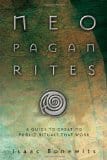
Neopagan Rites: A Guide to Creating Public Rituals that Work
by Isaac Bonewits
Llewellyn Worldwide, 0738711993, 264 pp. 2007
One of the things I have always admired about Isaac Bonewits is his ability to make complex subjects comprehensible to the average person without “dumbing down” the topics. He takes the time to explain his terminology before beginning and then proceeds to explain his position and/or beliefs in 3easy to understand, logical steps. This is not to say that his ideas are simplistic; they most certainly are not; nor are they necessarily non-controversial, in fact they are almost always thought provoking, if not debate inspiring.
I will confess, here and now, that I haven’t read a lot of Isaac’s literary output (only Real Magic: An Introductory Treatise on the Basic Principles of Yellow Magic and The Pagan Man: Priests, Warriors, Hunters, and Drummers
), but I have followed many of the debates his work has inspired, as well as being familiar with some of his work on the subject of Druidic research. I also had the pleasure of meeting him and attending a ritual he created many years ago at a Pagan gathering in the Midwest. I haven’t always agreed with him, but I have learned from him.
Isaac is sure to offend some readers by his no-nonsense approach to magic (i.e., “I suggest not doing magic or bothering deities with requests until after you’ve tried all other ethical means to solve your problem.”1 Given his many years of experience in the magical field I can only suggest that, should you be relatively new to the work, give him the benefit of the doubt.
If you are leading a group, or if you plant to lead a group, or if you are involved in a group, or even if you are a solitary practitioner who is interested in effective rituals, you need to add this book to your library. More importantly, you need to read this book and to work with the concepts contained within it. Far too many individuals pay far too little attention to the “nuts and bolts” of good ritual. Don’t be among that number. You owe it to yourself to benefit from the ideas contained within the covers of this book.
So what if you don’t agree with everything Isaac says? You can still benefit from what he provides.
- p. 152, italics in the original. [↩]








